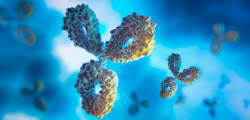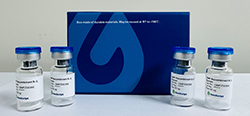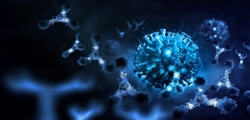
Figure 2. Dose dependent stimulation of intracellular cAMP accumulation upon treatment with U-50488 in CHO-K1/OPRK1/Gα15 cells. d2 acceptor fluorophore -labeled cAMP (Cat. No. 62AM4PEC; Revvity) and intracellular cAMP in CHO-K1/OPRK1/Gα15 cells competitively bind with Europium Cryptate-labeled anti-cAMP monoclonal antibody. The FRET signal decreases as the intracellular cAMP concentration rises and was measured by plate reader (Pherastar, BMG). The EC50 of U-50488 on CHO-K1/OPRK1/Gα15 cells was 42.36 nM.

Figure 1. U-50488-induced concentration-dependent stimulation of intracellular calcium mobilization in CHO-K1/OPRK1/Gα15 cells. The cells were loaded with Calcium-4 (Cat. No. R8142; Molecular Devices) prior to stimulation with OPRK1 agonist, U-50488. The intracellular calcium change was measured by FLIPRTETRA. The relative fluorescent units (RFU) were recorded and normalized to plot against the log of the cumulative doses of U-50488 (mean ± SEM, n = 3). The EC50 of U-50488 on CHO-K1/OPRK1/Gα15 cells was 11.07 nM.
Notes:
EC50 value is calculated with four parameter logistic equation:
Y=Bottom + (Top-Bottom) / (1+10^ ((LogEC50-X)*Hill Slope))
X is the logarithm of concentration. Y is the response.
Y is RFU and starts at Bottom and goes to Top along a sigmoid curve.
CHO-K1/OPRK1/Gα15 Stable Cell Line
| M00290 | |
|
|
|
| 询价 | |
|
|
|
|
|
|
| 联系我们 | |




































